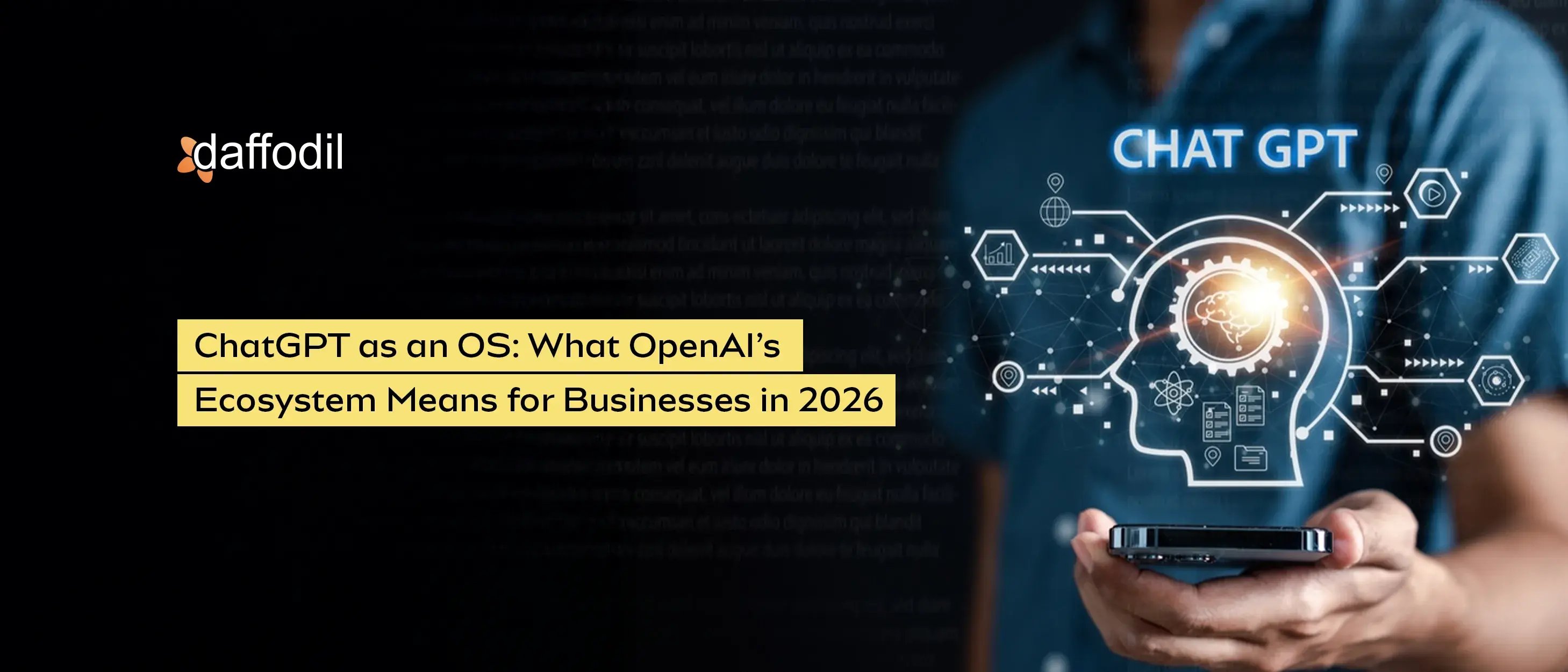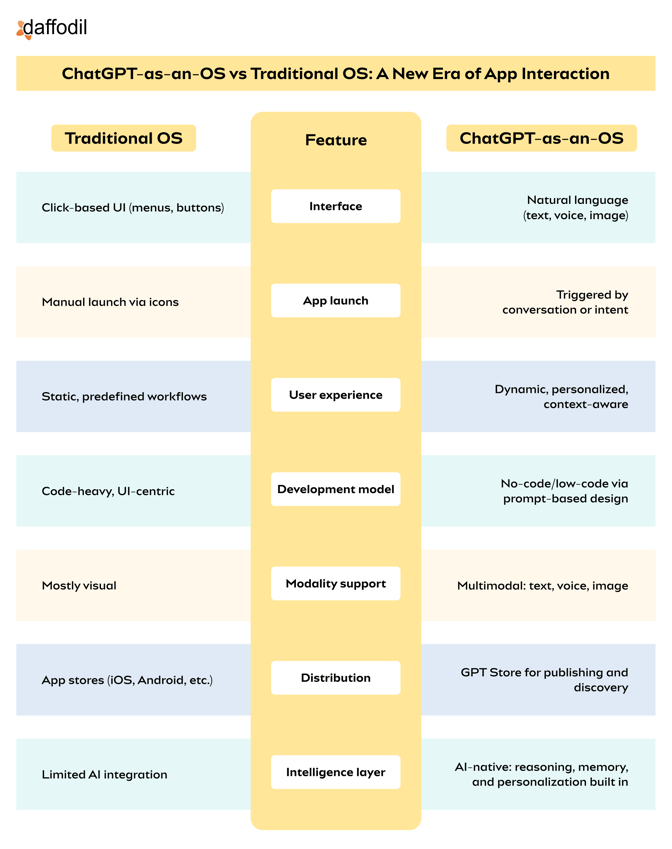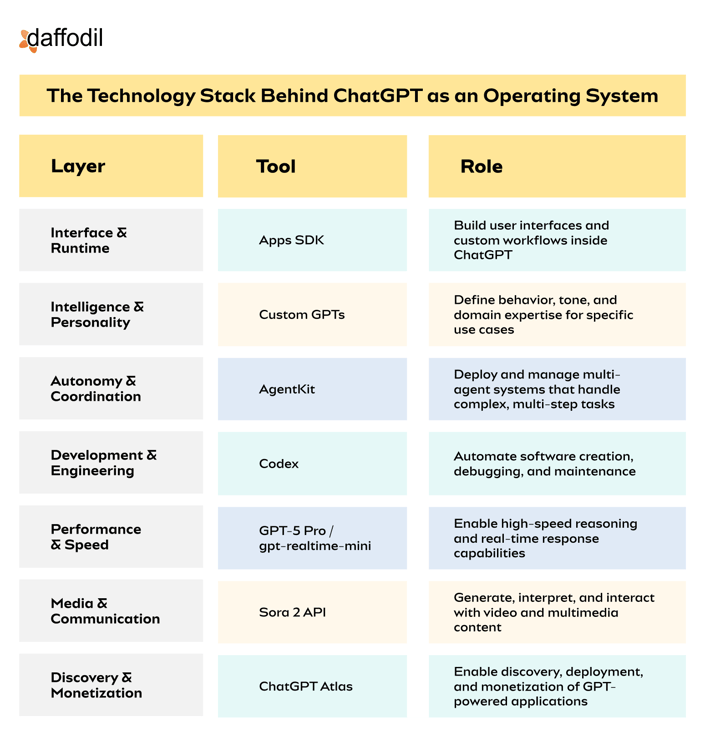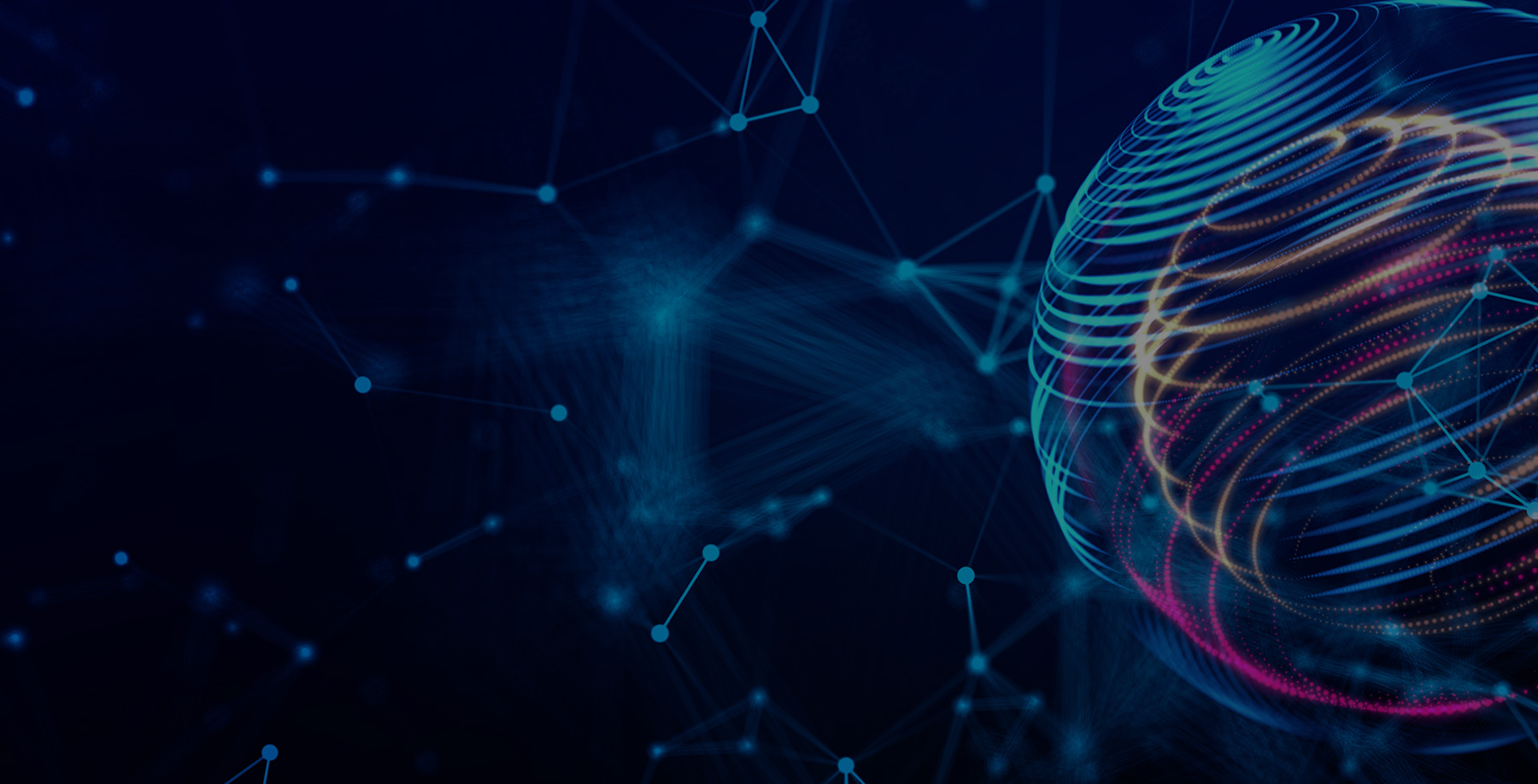
OpenAI’s ChatGPT has grown far beyond a chatbot. It’s now a powerful interface for building workflows, automating tasks, and launching custom GPTs designed for real business needs.
With OpenAI launching ChatGPT as the operating system for next-gen apps, entire workflows could now be automated with simple conversations. As ChatGPT handles over a billion prompts daily, one thing is sure: people want to talk to technology, not wrestle with it.
Think about your own customer experience. Some users won’t make it through a ten-step checkout flow; instead, they will simply prefer to say, “I need winter boots, size 9, under $100, shipped by Thursday.”
GPT understands that. It eliminates complexity and collapses the learning curve, turning friction into fluidity. It’s not just a tool, but the new operating system for intent-driven businesses.
You’re about to embark on a journey that lays out the blueprint for how ChatGPT OS is reshaping the way businesses build, deploy, and monetize software applications.
What does this OS shift mean for custom app ecosystems in 2026?

When we call ChatGPT an "operating system," we're not being metaphorical. Just as Windows and iOS became the foundational layers on which millions of applications run, ChatGPT is becoming the intelligence layer that will power entire business ecosystems in more ways than one.
1. Language is the new interface: The most profound shift is that natural language will now be the UI. No more clicking through menus or memorizing commands. You talk, and the system understands. This will democratize access to complex tools, helping businesses build, automate, and analyze without the hassle of manual work.
2. Faster development time: As ChatGPT evolves into this OS-like platform, it wields a new pace of innovation. What once took months and deep technical resources can now be prototyped in hours and launched in days.
3. User intent vs features: Traditional software apps competed by stacking up features like more buttons, more dashboards, more complexity. In contrast, GPT-oriented businesses can flip the model by deeply understanding user intent, maintaining context, and delivering personalized results through natural dialogue.
4. Multimodal input becomes standard: ChatGPT OS doesn’t just understand text; it seamlessly processes voice, images, and even video content. This means businesses can build tools that respond to spoken commands, analyze visual content, or combine the two in real time.
5. App orchestration replaces app switching: Instead of toggling between apps, ChatGPT can coordinate multiple agents and tools behind the scenes. For example, a single prompt like “Launch our new product” could trigger design generation, marketing copywriting, analytics setup, and CRM updates, all orchestrated by AI.
6. Dynamic permission management: Businesses can now define what each GPT or agent is allowed to access and do, whether it's reading customer data, sending emails, or initiating transactions. This granular control makes AI deployment safer and more scalable than traditional app permissions.
As ChatGPT transitions into a platform, the ability to package and monetize expertise becomes a defining advantage, turning insights into scalable, deployable value. Learn how.
ALSO READ: Predictive Project Management: Using AI Agents to Forecast Development Bottlenecks
GPT-native architecture: Building intelligent software on ChatGPT as the OS
GPTs are no longer just conversational tools; they’re becoming the connective tissue of modern ecosystems. Like embedded logic in a motherboard, they can connect inputs to actions, enabling real-time decisions, automation, and intelligent coordination across your tech stack.
This section explores how GPTs can connect to your systems, act autonomously, and allow even non-technical teams to build AI-based solutions.
Here’s how each OpenAI tool contributes to a different layer of the GPT-native architecture:

1. App SDKs
The AppSDK enables developers and businesses to build fully native applications within ChatGPT, with interactive interfaces and natural-language control.
Here are some key advantages of using an App SDK (Software Development Kit):
- Frictionless app deployment: Businesses can launch apps directly within ChatGPT, bypassing traditional app stores and reducing time-to-market.
- Unified AI interface: Apps live inside a conversational UI, enabling seamless integration of services like booking, shopping, or analytics without switching platforms.
- Cross-platform reach: Apps built with the SDK are instantly accessible across web, mobile, and desktop ChatGPT environments, maximizing user engagement.
2. Custom GPTs
Custom GPTs are personalized AI agents built on OpenAI’s GPT framework. Businesses can define their behavior, tone, knowledge base, and tool access, creating assistants tailored to specific roles and industries.
Some advantages of scaling with Custom GPTs:
- Brand-aligned AI assistants: Businesses can create GPTs that reflect their tone, policies, and domain knowledge, offering consistent customer experiences.
- Low-code automation: Non-technical teams can build powerful ChatGPT-enabled applications using natural language and simple configuration.
- Private knowledge integration: You can securely upload internal documents or APIs to create GPTs that act as expert advisors or internal tools.
3. AgentKit
It includes a drag-and-drop interface for designing workflows that connect tools, APIs, and logic blocks. It also uses the ChatKit framework to create intelligent AI agents that collaborate, make decisions, and execute tasks across systems.
Here are some key advantages of using an AgentKit:
- Autonomous workflows: Agents can complete complex tasks like onboarding, procurement, or lead qualification without human intervention.
- Composable logic: Developers can define reusable agent behaviors and decision trees, making it easy to scale and adapt across teams.
- Real-time optimization: Built-in tools for monitoring and refining agent performance help businesses continuously improve results.
4. Codex (GPT-5 Codex Model)
Codex can interpret intent, generate production-ready code, debug complex systems, and explain logic in plain language.
Some advantages of scaling with Codex:
- AI-enabled development: Codex can write, refactor, and explain code in multiple languages, accelerating development cycles.
- Legacy system modernization: Businesses can use Codex to migrate legacy codebases to modern frameworks with minimal manual effort.
- Secure-by-design coding: Codex can be trained to follow company-specific security and compliance rules, reducing vulnerabilities from the start.
5. GPT-5 Pro & GPT realtime mini
GPT-5 Pro is built for depth, offering advanced reasoning, long-term memory, and contextual awareness for complex tasks, while gpt-realtime-mini is built for speed. It is optimized for ultra-low-latency tasks in real-time applications such as voice assistants and embedded AI features.
Here are some key advantages of using GPT-5 Pro & gpt-realtime-mini:
- Real-time responsiveness: gpt-realtime-mini enables instant interactions for customer service, gaming, and live collaboration.
- Enhanced reasoning: GPT-5 Pro delivers deeper analysis, better memory, and more reliable outputs for critical applications.
- Cost-efficient scaling: Businesses can mix and match models based on latency and complexity needs, optimizing performance and budget.
6. Sora 2 API
Sora 2 is a next-generation video intelligence API that allows AI-enabled video generation, editing, and comprehension. It can synthesize realistic video content from text prompts, edit existing footage, and extract insights such as scene changes, objects, and spoken dialogue.
Some advantages of developing with the Sora 2 API:
- Instant video prototyping: Marketers and educators can generate product demos, explainers, or training videos from simple text prompts.
- Dynamic content creation: Apps can generate personalized video content on the fly for users, boosting engagement and retention.
7. ChatGPT Atlas
It is a discovery layer for GPT-enabled applications, functioning like an app store for intelligent agents.
Here are some key advantages of using ChatGPT Atlas:
- Unified knowledge access: Atlas connects GPTs to internal databases, documents, and APIs, enabling smarter, context-aware responses.
- Reinvent enterprise search: Employees can search for company knowledge/assets simply by asking questions, replacing clunky dashboards altogether.
- Data-driven decision support: GPTs powered by Atlas can synthesize insights across departments, showcasing trends, risks, and opportunities in a clear, actionable format.
And where there’s capability, there’s opportunity. As the ChatGPT-as-an-OS ecosystem matures, monetization models are quietly emerging, enabling developers, creators, and businesses to turn their GPTs into revenue-generating tools.
ALSO READ: Context Engineering for AI Agents: Building Smarter, More Aware Machines
Practical applications of ChatGPT as an OS across industries
1. Healthcare
- Leverage advanced AI solutions in healthcare to build AI-enabled conversational triage agents
- Automate clinical documentation using voice-to-text and NLP tools
- Monitor patient vitals and alert clinicians through conversational dashboards
2. Education
- Create adaptive learning environments with concept-based simulations and assessments in chat
- Tutor students in real time using curriculum-aware conversational AI agents
- Generate personalized study plans based on performance and learning style
3. Finance
- Guide users through decentralized finance by simplifying complex protocols
- Assist with loan applications and credit scoring using AI-driven dialogue
- Manage internal operations like auditing, reporting, and reconciliation through chat-based commands
4. Logistics
- Predict delays and reroute logistics based on real-time data and AI simulations
- Coordinate warehouse operations using voice or text commands
- Optimize fleet performance and fuel usage through AI-driven insights in chat
5. Manufacturing
- Monitor supplier network, geopolitical risks, and material availability
- Manage factory floor operations through natural language commands
- Predict equipment failures using conversational analysis of sensor data and maintenance logs
6. SaaS Products
- Leverage autonomous dev teams (agents) to build end-to-end microservices
- Automate customer onboarding, support, and training through a unified conversational interface
- Manage product updates, release notes, and user feedback via AI-driven workflows
7. Telecom
- Autonomously configure and deploy edge infrastructure, dynamically scaling 5G nodes
- Monitor network performance and trigger maintenance using conversational alerts
- Automate provisioning and activation of services through natural language commands
8. Marketing
- Generate hyper-personalized ads in minutes using AI agents
- Manage brand assets, approvals, and timelines through a single chat interface
- Analyze customer sentiment and engagement data via conversational dashboards
9. E-Commerce
- Build AI shopping assistants that handle product discovery, comparison, and checkout in chat
- Automate inventory updates, pricing strategies, and promotions via conversational tools
- Coordinate logistics, returns, and vendor communication through a centralized chat OS
ALSO READ: Top 8 Agentic AI Use Cases In E-Commerce
How to monetize apps built on ChatGPT OS?
ChatGPT OS allows developers and businesses to build intelligent, task-oriented apps that can reason and act across digital environments. These apps are not just tools; they're economic actors capable of generating, capturing, and exchanging value.
From subscription-based services to performance-driven commissions, the monetization landscape is rapidly expanding. Below are key monetization models that illustrate how businesses can generate revenue with GPT-native capabilities:
1. Agent-as-a-Service (AaaS)
In this model, businesses subscribe to autonomous GPT agents that manage end-to-end workflows, including procurement, compliance, and onboarding. These agents operate independently across company-wide systems, with pricing models based on the complexity and scope of each task.
2. Commission-based agents
GPT agents can function as intelligent brokers, earning commissions for completing tasks such as closing sales leads, sourcing suppliers, or matching talent. In domains such as e-commerce, HR, and logistics, these agents can autonomously negotiate, recommend options, and execute transactions, helping generate revenue through performance-based results.
3. Dynamic micro-transactions
GPT apps can deliver real-time microservices such as generating property purchase agreements, creating personalized video ads, or translating legal documents on demand. Users pay per action or insight, with dynamic pricing that adjusts based on urgency, complexity, or relevance.
4. Intelligence licensing
Businesses can license GPT-generated strategic insights, forecasts, and simulations, such as market-entry plans or risk-mitigation models, tailored to specific domains. Here, pricing is determined by factors such as domain complexity, data freshness, and exclusivity.
This model establishes a new market for AI-generated intellectual property, particularly valuable across sectors such as finance, geopolitics, and R&D.
5. Agent network royalties
Businesses can earn royalties when other agents utilize their GPT agents within multi-agent workflows. This model promotes inter-agent collaboration, encourages the reuse of intelligence, and drives ecosystem growth across shared AI infrastructure.
6. GPT-native sponsorships
GPT-native sponsorships are context-aware, intent-driven promotions that appear naturally during a GPT interaction. Instead of showing traditional ads, the GPT app recommends sponsored options that are relevant to the user's current goal.
ALSO READ: Rise of Multi-Agent AI Systems: What You Need to Know?
What are the key things to consider before building GPT apps?
While ChatGPT’s low-code tools make AI app development more accessible than ever, it’s essential to recognize their limits. For simple workflows and internal tools, they’re highly effective; however, for complex infrastructure, sensitive data environments, and high-reliability applications, the following should be addressed.
- System integration: Without smart integration, GPTs risk becoming siloed tools. Use secure APIs and connectors to ensure seamless data flow across your systems.
- Data governance: When GPTs access customer or internal data, fine-grained permissions are essential to protect sensitive information, ensure compliance, and build user trust.
- Design mindset shift: Building GPT-native apps means designing conversations, not just code. Thinking in terms of prompts and workflows will help deliver smarter, faster, and more intuitive user experiences.
- Accuracy and trust: To ensure reliability, especially in high-stakes business processes, it's essential to include human-in-the-loop validation. Adding human reviews in the mix helps catch errors, reduce hallucinations, and maintain user confidence.
- Brand and compliance alignment: Your GPTs should reflect your brand’s voice and values.. Ensure your ChatGPT app aligns with the brand’s tone, messaging, and behavior, while staying compliant across industries.
- Democratizing app development: ChatGPT OS makes app-building accessible to everyone. Non-technical teams can now create innovative solutions using just natural language, helping solve problems, automate tasks, and launch new ideas, without depending on engineers.
Wrapping up
The next frontier is multi-modal, agentic systems. GPT applications will evolve beyond text to see, hear, and act autonomously. Fast forward to 2036, and the GPT ecosystem will become the neural fabric of modern businesses, transforming into Self-Evolving Cognitive Layers (SECLs). Those dynamic, adaptive entities that serve as organizations' digital consciousness. This shift will help redefine workflows, decision-making, and customer engagement through AI-native interfaces.
And businesses that embed GPTs as living layers of intelligence will move from being AI-enabled to AI-structured, delivering enduring value.
Get tailored guidance on building and deploying GPT-enabled applications. Schedule your free consultation today.

-1.png?width=1504&height=394&name=Technology%20CTA%20BANNER%20(3)-1.png)


